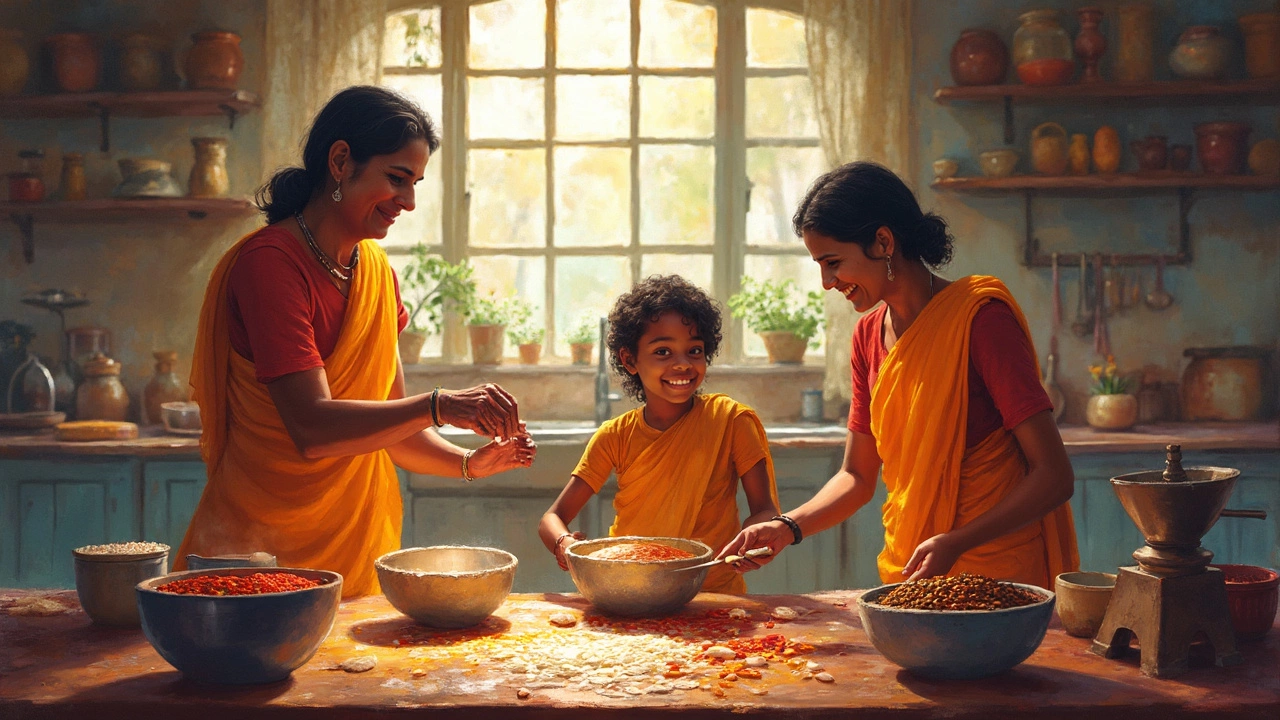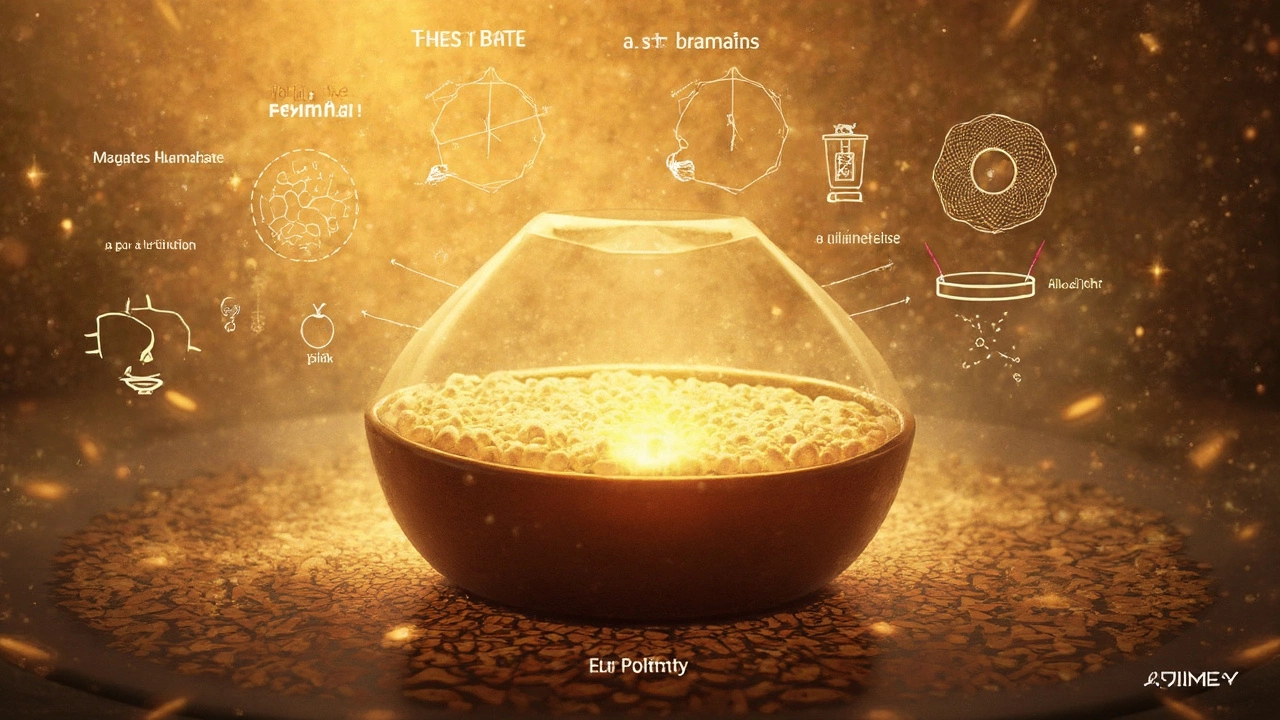Mastering Dosa Batter Without Yeast for Perfect Results
 Feb, 16 2025
Feb, 16 2025
Who doesn't love a crispy, golden dosa? It's the ultimate comfort food that hails from South India and is loved everywhere. But sometimes, making dosa batter can come across as a daunting task, especially when you're trying to avoid yeast. Trust me, it's simpler than you think.
The secret lies in understanding the fermentation process. Traditionally, dosa batter is made by soaking and grinding rice and urad dal. The magic happens when you let this mix sit and ferment, thanks to naturally occurring air microbes. No yeast needed here!
Choosing the right ingredients is crucial. What kind of rice should you go for? Short answer—parboiled or idli rice works best. These create a batter that not only ferments well but also yields that soft, yet crispy exterior we all crave in a dosa.
- The Basics of Dosa
- Choosing Your Ingredients
- The Fermentation Process
- Common Mistakes to Avoid
- Cooking Perfect Dosas
- Troubleshooting Tips
The Basics of Dosa
Dosa, a thin and crispy pancake, is a staple in South Indian cuisine. It's made from a fermented batter primarily consisting of rice and urad dal. There's something deeply satisfying about getting these homemade delights just right. And the best part? You don't need any special equipment or ingredients—it's all about technique and patience.
Let's chat about dosa batter. The traditional way to make this batter involves soaking the rice and dal separately before blending them into a smooth consistency. Parboiled rice is commonly used because it absorbs water well, encouraging fermentation. This is critical because it leads to the characteristic tangy flavor and texture of a good dosa.
Getting the Right Ratio
The typical ratio is 3:1 of rice to urad dal, but this isn't set in stone. You can tweak it a bit based on your taste and texture preference. Some even add a spoon of soaked fenugreek seeds for extra flavor and to help fermentation.
Fermentation: The Natural Way
Now, fermentation is where the magic happens. Once the batter is ground, you let it sit in a warm place. The natural bacteria in the environment kickstart the process, usually taking about 8-12 hours, depending on your climate. It's this fermenting phase that makes the batter airy and gives the dosa its signature flavor.
Not only is it a test of patience, but also of intuition. The batter will double in size and should have a slightly sour smell—this is a good sign it’s ready.
Interesting fact: Did you know that dosas are not just a favorite in Indian households? They have found a place on tables worldwide, owing to their gluten-free nature and versatility. It's a simple dish that, with the right process, can transform into something extraordinary.
Choosing Your Ingredients
Getting the ingredients right is step one in making a great dosa. You'd be amazed at how just a few simple tweaks here and there can make all the difference. Let’s break it down.
The Right Rice
Dosa batter really shows off when you choose good rice. Your best bet is parboiled or idli rice. These varieties have the perfect amount of starch, which helps in fermenting just right and makes the dosas crisp and fluffy all at once. And hey, if you can't find them, regular long-grain or basmati rice can work too, but you might have to adjust your soaking time a bit.
The Crucial Urad Dal
You can't make a proper dosa batter without urad dal. Black gram split without the skin is what you're looking for, specifically, the white variety. It's loaded with proteins and helps create that iconic texture when fermented. Make sure it’s fresh for the best results.
Optional Add-ins
If you want to get a bit fancy, include a tablespoon or two of chana dal or fenugreek seeds while soaking. They act as fermentation kick-starters. Chana dal gives an enhanced color and fenugreek aids the batter’s fermentation process, which is a neat trick if you're struggling to get those bubbles.
Water Quality
Even water can change the game here. Use clean, filtered water for soaking and grinding. It not only affects the taste but also the fermentation process. Tap water can sometimes have chlorine, which is not ideal.
Here’s a quick look at your soaking basics:
| Ingredient | Soaking Time |
|---|---|
| Rice | 4-6 hours |
| Urad Dal | 4-6 hours |
Mastering these ingredient choices will get your dosa game on point, even without yeast. Stick with the basics, and you’re halfway there to making a killer batter.
The Fermentation Process
So, what's the deal with fermentation and its role in making dosa batter without yeast? It's actually an ancient trick that involves exploiting natural microbes in the environment to get that perfect batter texture. The two main ingredients, rice and urad dal, both have a role to play here.
The Role of Ingredients
Rice provides the sugars needed for fermentation. When soaked, these sugars become accessible, making it easier for the naturally occurring lactobacilli and yeast in the air to feed on them. Meanwhile, the urad dal is packed with proteins that add to the overall fermentation and give the dosa batter its strength.
Timing it Right
Getting the timing right for fermentation is key. Usually, allowing the batter to sit for about 8 to 12 hours in a warm place should do the trick. If you live in a cooler climate, you may need to extend this time. Many dosa fans have found that placing the covered bowl of batter in an oven with a light on provides just the right amount of warmth.
Signs of Perfect Fermentation
So, how do you know when it's ready? The fermented batter should have a slight rise, a mild sour smell, and a few bubbles on the surface. These are all good signs that nature has worked its magic and the batter is ready to be spun into crispy dosas.
Benefits of Fermentation
Fermentation not only helps the batter rise but also breaks down complex carbohydrates and proteins, making the dosa easy to digest. Plus, it's a powerhouse of probiotics, which are great for gut health.

Common Mistakes to Avoid
Making dosa batter without yeast is a rewarding process, but it does come with its own set of challenges. Let's dive into the most common pitfalls so you can steer clear of them and ensure perfect results every time.
1. Incorrect Rice and Dal Ratio
The ratio of rice to urad dal is key for well-fermented batter. The traditional wisdom calls for a mix of about 3:1 or 4:1. Deviating from this can lead to poorly fermented batter, resulting in dosas that are either too dense or too brittle.
2. Skipping the Soak
Soaking the rice and dal is essential. You should soak them separately because they have different textures and require different soaking times. Aim for at least 6-8 hours. Skipping this step can lead to uneven grinding and ultimately, an unsatisfactory batter.
3. Not Grinding Properly
Grinding is where you start turning ingredients into batter. The goal is a smooth, frothy blend. To get a smooth consistency, grind rice slightly coarse and dal smooth. Add water gradually to avoid a watery mess.
4. Fermenting at the Wrong Temperature
Fermentation is temperature-sensitive. Ideally, keep your batter in a warm place. If you live in a cold climate, try an oven's light or wrap it in a blanket. Without proper fermentation, you miss that signature tangy flavor.
5. Using Old Batter
Batter doesn't last forever. After fermentation, use the batter within a week for best results. Storing it too long can affect the taste and quality of the dosas.
- If it's too sour, it's fermented for too long.
- If there's a smell, it might be over-fermented.
Avoid these blunders, and you'll be whipping up restaurant-quality dosas at home in no time.
Cooking Perfect Dosas
Alright, you’ve nailed that dosa batter and it's bubbling just right! Now comes the fun part: cooking those dosas to a golden-brown perfection. It might seem tricky at first, but with a bit of practice, anyone can become a dosa pro.
Get the Right Pan
Your pan can make or break your dosa. A cast iron tawa is often the go-to choice for that lovely, even brown. Non-stick works too, but purists swear by cast iron, since it gives a better texture.
Heat it Right
Temperature matters more than you think. Preheat your pan well. It should sizzle when a bit of water is sprinkled on it then evaporate immediately. Too hot, and the dosa won't spread right; too cold, and it'll stick.
Spread Like a Pro
Pour a ladleful of batter onto the center of the pan and use the back of the ladle to spread it in a circular motion. Go spiral, working outward. Aim for an even thickness.
Oil and Flip
Drizzle a little oil around the edges. This not only helps in cooking but also lifts the edge when it’s time to flip. Once the bottom is golden and the edges lift easily, flip it and cook for a short time on the other side. Remember, crisp dosa results from just the right flip!
Serve Hot
Nothing beats a freshly made dosa. Serve immediately with your favorite chutneys or sambar.
Troubleshooting Dosa Issues
- If the dosa sticks, either the pan isn't hot enough or there’s too much water in the batter.
- If it’s too thick, add a bit of water to the batter to get the right consistency.
- If it’s not crispy, try cooking it a bit longer or ensure the batter isn’t too wet.
Cooking perfect dosas takes a bit of practice, but with these tips, you’re on your way to dosa mastery!
Troubleshooting Tips
Even seasoned cooks run into a hiccup now and then, especially with something as technique-sensitive as dosa batter. Here are some common issues and practical solutions to help you perfect your craft without a hitch.
Why Isn't the Batter Fermenting?
This one's a classic headache! If your batter isn't rising or developing that signature tangy smell, a few things might be off.
- Temperature Trouble: The environment plays a huge role in fermentation. If it's too cold, the process slows down. Try placing the batter in a warm spot like inside a switched-off oven or near a cozy lamp.
- Ratios Matter: An imbalance of rice and urad dal can affect fermentation. Stick to a 3:1 or 4:1 rice to dal ratio for best results.
- Freshness Factor: Check your ingredients! Old or expired dal might be causing the issue. Fresh is always best.
Consistency Confusion
So you've got the fermentation down, but your dosa isn't spreading right? It's all about the consistency!
- Too Thick? An overly thick batter won’t spread thin. Adjust by adding a splash of water until it's a slightly thick, pouring consistency.
- Too Thin? On the flip side, a watery batter will give you crepe-like dosas. Mix in a bit of rice flour to thicken it up.
Getting the Cook Right
You've nailed the batter, but cooking's a whole new ball game. Here are some tips to get that perfect crisp:
- Hot Griddle: Preheat your pan; it should sizzle when you splash water on it. But don’t go overboard—medium-high heat is ideal.
- Oil Situation: Too much oil will make your dosa greasy. Use a light hand—just a teaspoon should suffice.
- Spreading Skill: Start from the center and work your way outwards in a circular motion using the back of a ladle. Consistency is key!
With these tips in mind, making a perfect dosa without yeast becomes more about the process and less about stress. Happy cooking!